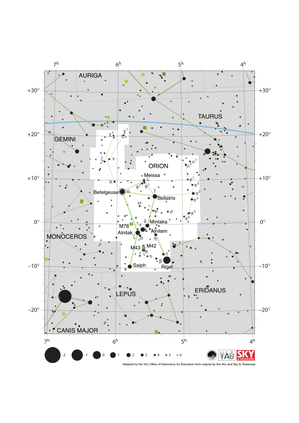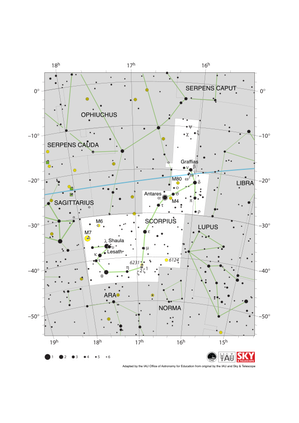Glossarbegriffe: Scheinbare Helligkeit
Description: Die scheinbare Helligkeit ist ein Maß dafür, wie hell ein Himmelskörper einem Beobachter erscheint. Sie wird als Magnitude (mag) angegeben, einer Zahl auf einer logarithmischen Skala, wobei ein Unterschied von 5 Magnituden einem Faktor von 100 in der gemessenen Helligkeit entspricht. Aus historischen Gründen haben weniger helle Objekte größere Zahlen auf der Magnitudenskala.
Es gibt viele Magnitudenskalen, da die Helligkeit bei verschiedenen Wellenlängen und mit verschiedenen Techniken gemessen werden kann. Die Skala der "visuellen Helligkeit" ist so eingestellt, dass der helle Stern Wega eine scheinbare Helligkeit von Null hat. Auf dieser Skala hat Sirius, der hellste Stern am Nachthimmel, eine Helligkeit von -1,46. Die Helligkeit der Sonne und des Vollmondes beträgt -26,7 bzw. -12,7. Die negativen Zahlen bedeuten, dass diese Objekte heller erscheinen als Wega. Unter sehr dunklen Bedingungen können Menschen mit ausgezeichnetem Sehvermögen Sterne mit einer visuellen Helligkeit von bis zu 6 mag sehen. Das Hubble Ultra Deep Field erreicht eine visuelle Helligkeit von etwa 31. Das ist etwa 100 hoch 5 oder 10.000.000.000 Mal weniger hell als die Magnitude 6.
Zugehörige Glossarbegriffe:
See this term in other languages
Term and definition status: The original definition of this term in English have been approved by a research astronomer and a teacher The translation of this term and its definition is still awaiting approval
The OAE Multilingual Glossary is a project of the IAU Office of Astronomy for Education (OAE) in collaboration with the IAU Office of Astronomy Outreach (OAO). The terms and definitions were chosen, written and reviewed by a collective effort from the OAE, the OAE Centers and Nodes, the OAE National Astronomy Education Coordinators (NAECs) and other volunteers. You can find a full list of credits here. All glossary terms and their definitions are released under a Creative Commons CC BY-4.0 license and should be credited to "IAU OAE".
If you notice a factual or translation error in this glossary term or definition then please get in touch.
Related Diagrams
Andromeda Constellation Map
Bildnachweis: Adapted by the IAU Office of Astronomy for Education from the original by IAU/Sky & Telescope
License: CC-BY-4.0 Creative Commons Namensnennung 4.0 International (CC BY 4.0) icons
Crux Constellation Map
Bildnachweis: Adapted by the IAU Office of Astronomy for Education from the original by IAU/Sky & Telescope.
License: CC-BY-4.0 Creative Commons Namensnennung 4.0 International (CC BY 4.0) icons
Orion Constellation Map
Bildnachweis: Adapted by the IAU Office of Astronomy for Education from the original by IAU/Sky & Telescope
License: CC-BY-4.0 Creative Commons Namensnennung 4.0 International (CC BY 4.0) icons
Libra Constellation Map
Bildnachweis: Adapted by the IAU Office of Astronomy for Education from the original by IAU/Sky & Telescope
License: CC-BY-4.0 Creative Commons Namensnennung 4.0 International (CC BY 4.0) icons
Scorpius Constellation Map
Bildnachweis: Adapted by the IAU Office of Astronomy for Education from the original by IAU/Sky & Telescope
License: CC-BY-4.0 Creative Commons Namensnennung 4.0 International (CC BY 4.0) icons













